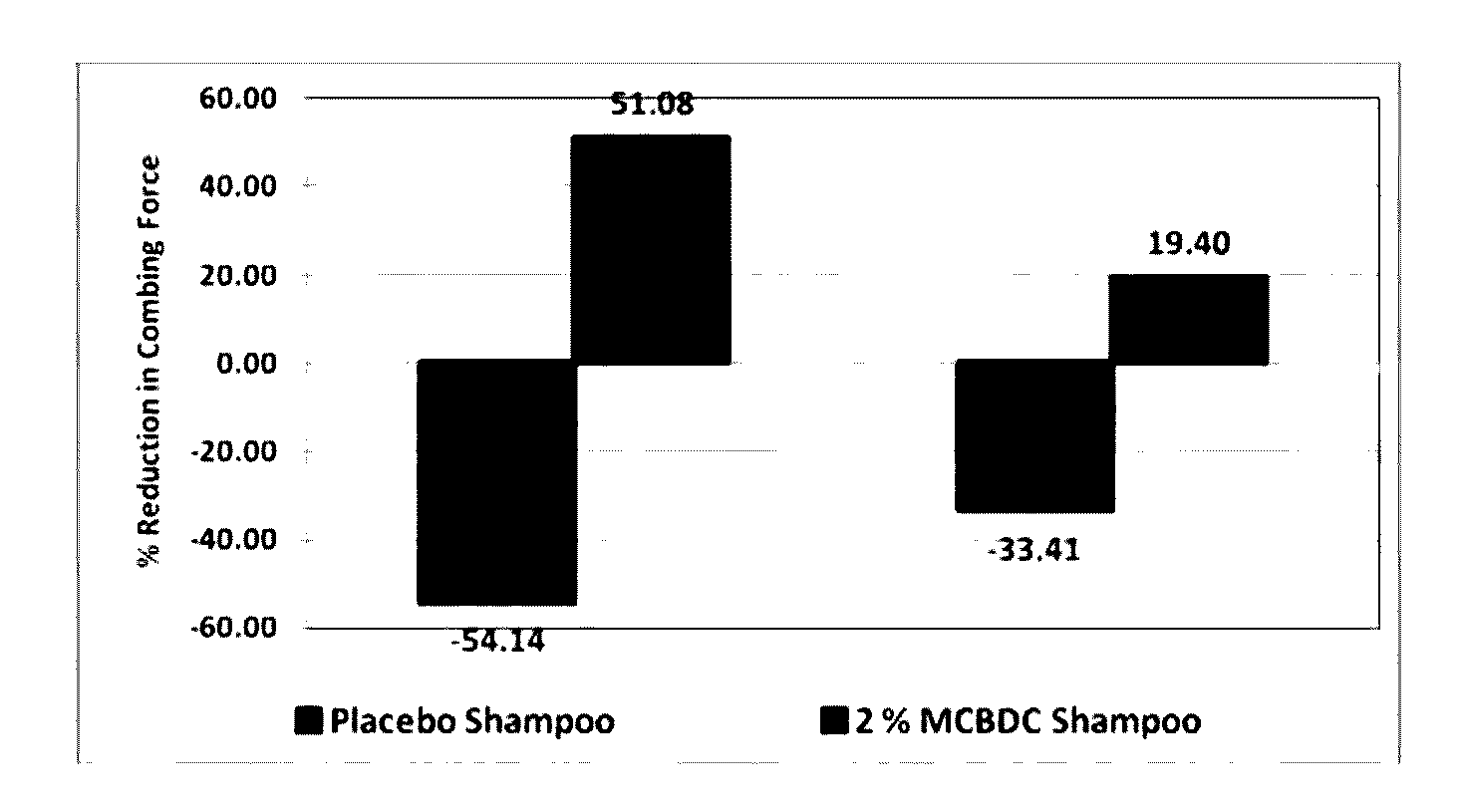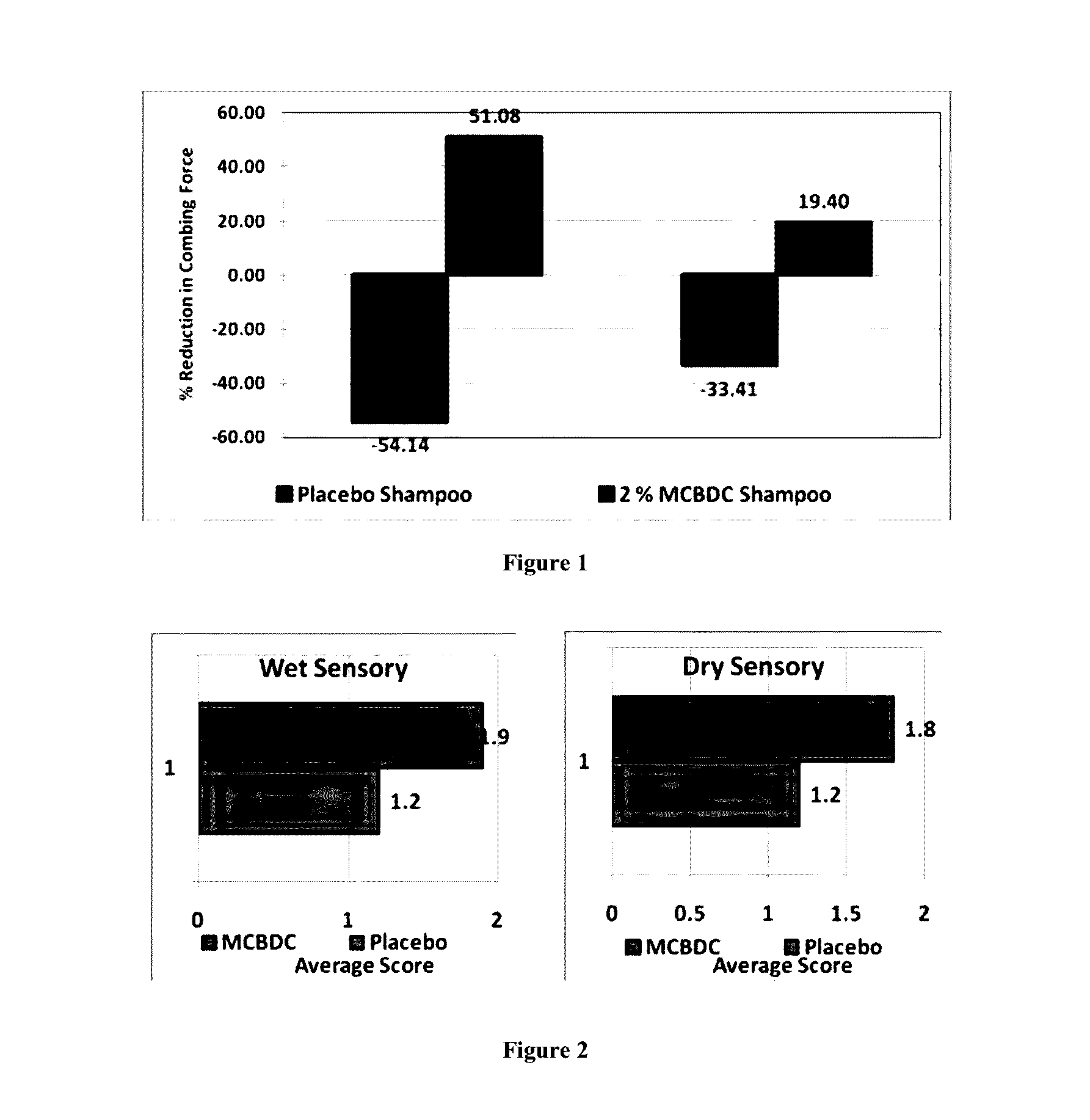Multifunctional hair color protector
a hair color protector and multi-functional technology, applied in the field of multi-functional hair color protectors, can solve the problems of color applied on the hair, the color is susceptible to the damaging effect of light and heat, and the color is appreciably fading, so as to reduce combing work, the effect of reducing the damage to the hair tresses and high UV absorption power
- Summary
- Abstract
- Description
- Claims
- Application Information
AI Technical Summary
Benefits of technology
Problems solved by technology
Method used
Image
Examples
example 1
Synthesis of p-Methoxy Cinnamido Propyl Dimethyl Amine
[0049]To a stirred solution of N,N-dimethyl aminopropylamine (60.6 g 0.58 gmol) in water (35 mL) at room temperature, under nitrogen blanket, molten p-methoxy cinnamoyl chloride (103 g, 0.52 gmol) was slowly added while maintaining the temperature between 50 to 55° C. over the period of 1 hr. The stirring was continued for additional two hours. At this stage water (20 mL) was added and the reaction mixture was cooled to 10° C. and was acidified with concentrated hydrochloric acid to pH of 2. The hydrochloride salt solution was filtered and the filtrate was basified using sodium hydroxide (45% solution) to the pH of 11. The product, p-methoxy cinnamidopropyl dimethyl amine precipitated as off white solid. It was filtered, washed with water and dried under vacuum at 40° C. to yield the amidoamine (126.0 g, 89%) as pale yellow colored solid (m.p. 92° C.).
[0050]Molar extinction coefficient, ε, in methanol was found to be 24,224 at 29...
example 2
Synthesis of p-Methoxy Cinnamidopropyl Behenyl Dimethyl Ammonium Chloride (MCBDC)
[0053]A mixture of p-methoxy cinnamido propyl dimethyl amine (120 g, 0.45 gmol), behenyl chloride (155 g, 0.45 gmol) in water (645 mL) was heated in a stainless steel pressure reactor after purging the vessel with nitrogen for half hour and was filled with nitrogen (1 kg / cm2). The reaction mass was stirred at 140° C. for four hours and the progress of the reaction was monitored by analyzing the free methoxy cinnamido propyl dimethyl amine. Reaction was continued for additional 4 hr after the free amidoamine of less than 0.5% was achieved. The reaction mass was cooled to 70° C. and drained in the container to yield the quaternary product (900 g) as off-white paste. (solids content 30.2%, chloride ion content 1.7%, free cinnamidoamine 0.2%)
[0054]IR showed carbonyl stretching of amide at 1659 cm−1 and NH stretching at 3377 cm−1, CH stretch at 2917 and 2849 cm−1
[0055]The white pasty mass that is practicall...
example 3
Synthesis of p-Methoxy Cinnamidopropyl Behenyl Dimethyl Ammonium Chloride (MCBDC)
[0057]A mixture of p-methoxy cinnamido propyl dimethyl amine (100 g, 0.38 gmol), behenyl chloride (130 g, 0.38 gmol) in water (25 mL) was heated in a stainless steel pressure reactor after purging the vessel with nitrogen for half hour and was filled with nitrogen (1 kg / cm2). The reaction mass was stirred at 150° C. for eight hours and the progress of the reaction was monitored by analyzing the free methoxy cinnamido propyl dimethyl amine. Reaction was continued for additional 4 hr after the free amidoamine of less than 1.0% was achieved. The reaction molten reaction mass flaked by evenly spreading in a steel tray and was scrapped of as fine solid flakes. The yield was quantitative with anionic activity of 89% by two phase titration against standard anionic surfactant.
PUM
| Property | Measurement | Unit |
|---|---|---|
| temperature | aaaaa | aaaaa |
| temperature | aaaaa | aaaaa |
| temperature | aaaaa | aaaaa |
Abstract
Description
Claims
Application Information
 Login to View More
Login to View More - R&D
- Intellectual Property
- Life Sciences
- Materials
- Tech Scout
- Unparalleled Data Quality
- Higher Quality Content
- 60% Fewer Hallucinations
Browse by: Latest US Patents, China's latest patents, Technical Efficacy Thesaurus, Application Domain, Technology Topic, Popular Technical Reports.
© 2025 PatSnap. All rights reserved.Legal|Privacy policy|Modern Slavery Act Transparency Statement|Sitemap|About US| Contact US: help@patsnap.com



